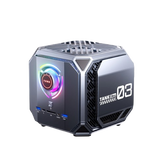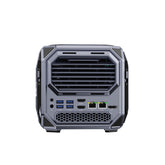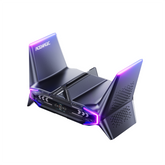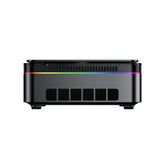Intel Core i9 vs AMD Ryzen 9: Which Flagship CPU Fits You Better?
When you move into the flagship tier, Intel Core i9 and AMD Ryzen 9 start to look very similar on paper. Both lines offer high core counts, aggressive boost clocks, and enough horsepower for high-refresh gaming, 4K video editing, and heavy multitasking. The problem is not "which one is objectively better," but "which one makes more sense for the way you actually use your PC."

This guide focuses on practical choices rather than spec charts. You’ll see how i9 and Ryzen 9 differ in gaming, content creation, power and thermals, platform costs, and long-term use. By the end, you should be able to match one of them to your own mix of gaming, work, and form factor needs.
Core differences at a glance
Before diving into details, it helps to build a quick mental model of each line. Think of both as high-end CPUs with slightly different strengths, depending on workload and platform.
| Aspect | Intel Core i9 (recent gens) | AMD Ryzen 9 (recent gens) |
| Design style | Mix of performance cores and efficiency cores | Many high-performance cores, chiplet design |
| Gaming at 1080p | Often a small edge in some high-FPS titles | Very close; small gaps vary by game and generation |
| Heavy content creation | Strong; can lean on high clocks and accelerators | Often excellent in multi-threaded tasks |
| Power and thermals | Can pull high power under boost; needs solid cooling | Also demanding, but implementations can be more varied |
| Platform & upgrades | Depends on current socket generation | Known for longer socket support in some generations |
| Typical use profile | Great for high-FPS gaming and mixed workloads | Great for creators, multi-taskers, and mixed workloads |
The rest of the article fills in these boxes so they mean something concrete for your build.
Architecture and specs
How Intel Core i9 is typically built
Recent Intel Core i9 desktop and mobile CPUs use a hybrid approach with two types of cores:
- Performance cores designed for heavy, latency-sensitive tasks like games and foreground apps
- Efficiency cores that handle background tasks, light threads, and some parallel workloads
This layout aims to keep foreground tasks responsive while the system is busy. High boost clocks help in workloads that favor strong single-thread performance, like high-FPS game engines and some lightly threaded creative tools.
How AMD Ryzen 9 is typically built
Ryzen 9 models are usually based on a chiplet design with many similar cores grouped into core complexes. Instead of mixing two core types, they tend to offer a larger number of full-fat cores with strong multi-thread performance and substantial shared cache.
This approach scales well for rendering, encoding, compilation, virtual machines, and other workloads that can occupy a lot of threads at once.
What these specs actually mean in daily use
The important part is how you feel these design choices:
- In games, single-thread speed and cache behavior affect frame rate and frame-time consistency.
- In creative work, the number of strong cores and their sustained clocks influence how long you wait for exports and renders.
- In multitasking, a healthy mix of cores and good scheduling means fewer hitches when you have a browser, editor, chat apps, and background tasks open at the same time.
If you want a clearer picture of what CPU cores actually do and how core counts affect real workloads, you can refer to our dedicated guide to CPU cores. It breaks down core types, threads, and typical use cases in more detail, with examples that are easier to map to your own PC.
Gaming performance
1080p high-refresh gaming
If you play competitive titles at 1080p with a 144 Hz or faster monitor, the CPU has more room to affect outcomes. Game engines that push very high frame rates can show a few-to-double-digit differences between i9 and Ryzen 9 models, depending on:
- How the game engine is optimized
- How heavily it leans on single-thread performance
- Which generation of each CPU line you compare
These gaps look impressive on a chart but may not always translate into a visibly different experience. If you already have a powerful GPU and a fast monitor, a small uplift can still be valuable, especially in esports titles, but it is worth keeping in perspective.
1440p and 4K: when the GPU takes over
At 1440p and 4K, the GPU almost always becomes the main constraint. In many titles, frame-rate differences between i9 and Ryzen 9 shrink to the point where your graphics card and graphics settings matter far more than your choice of flagship CPU.
If your main goal is smooth high-resolution gaming, it often makes more sense to:
- Choose a strong but not extreme CPU from either line
- Put more of your budget toward the GPU and display
Platform features that affect games
Some game setups rely heavily on platform details:
- PCIe lanes and versions for GPUs and NVMe drives
- Memory speed and latency, especially with DDR5
- Motherboard quality and firmware tuning
When you care about capturing, streaming, or loading large open-world games from fast SSDs, these platform details start to matter as much as a few percent difference in pure CPU performance.
Content creation and productivity
Video editing and timeline performance
In video editing tools, you feel CPU behavior in two main places:
- Timeline responsiveness: scrubbing and preview playback, especially with high-bitrate or high-resolution footage
- Export and render times: how long you wait for a final file
High-end i9 and Ryzen 9 CPUs both provide enough power for 4K workflows in tools such as Premiere Pro, DaVinci Resolve, or similar editors. In some workflows, hardware accelerators or specific codec support can tilt the scales toward one platform; in others, the raw multi-thread performance of many cores dominates.
The practical takeaway: if you care about editing speed, pick the CPU that pairs well with your editor, GPU, and storage. Both lines can handle serious editing; the real differentiator is your overall workstation configuration.
3D rendering, data work, and development
Tasks that scale cleanly with threads—3D rendering, software compilation, certain data analysis workloads, and running multiple virtual machines—tend to reward more strong cores and stable sustained clocks.
Ryzen 9 parts often look attractive in this area because of their core counts and scaling in multi-threaded workloads. Top-end i9 models are also very capable here, especially when paired with strong cooling that allows them to maintain high clocks for long periods.
If you spend most of your day waiting on code builds, renders, or simulations, looking at multi-thread benchmarks and core counts is more valuable than chasing a small edge in gaming tests.
Long sessions and system stability
For long render or compile sessions, stability and noise become part of performance. A CPU that runs at the edge of your cooler’s capabilities may clock down more often, and fans may have to spin aggressively.
Here, your choice of case, cooler, and power supply matters just as much as your choice of i9 or Ryzen 9. A balanced configuration that maintains consistent performance for hours is usually more valuable than squeezing a few extra megahertz under short bursts.
Power, thermals, and cooling expectations
Why TDP numbers can be misleading
The thermal design power (TDP) listed on a spec sheet is not a strict cap on power draw. Actual behavior depends on:
- Motherboard power limits and default profiles
- Boost algorithms and how long the CPU is allowed to sustain them
- The strength of your cooler and case airflow
High-end i9 and Ryzen 9 CPUs can both pull significantly more power under heavy workloads than their base numbers suggest. When planning a build, assume you will need a robust cooler and decent case airflow rather than relying on a single spec line.
Different form factors, different constraints
The same CPU tier behaves differently in a tower, a small form factor build, and a mini PC.
- Full-size tower: easiest way to cool a flagship CPU; you can use large air coolers or 240–360 mm liquid coolers.
- Small form factor desktop: still workable, but you need to be more careful with cooler height, airflow patterns, and GPU choice.
- Mini PC: thermal headroom and power budgets are much tighter. Performance often depends on how well the vendor designed the cooling system and tuned boost behavior.
If you plan to use an i9 or Ryzen 9 in a compact or prebuilt system, it is worth checking how that specific chassis handles sustained loads rather than assuming all systems with the same CPU will behave alike.
Platform, features, and overall budget
Motherboard and memory considerations
Flagship CPUs usually sit on the top tiers of each platform. That means:
- Motherboards with stronger power delivery and richer features tend to cost more
- You may be pushed toward DDR5 memory and higher-end chipsets, raising the platform price
On the other hand, these boards often provide what you want in a high-end system anyway: more USB ports, multiple M.2 slots, better networking, and more stable power delivery under heavy loads.
Expansion and future upgrades
If you think you might upgrade GPU, add more NVMe drives, or expand RAM in the next few years, expansion options matter:
- Number and placement of PCIe slots
- How many M.2 slots run at full speed
- Maximum supported memory capacity and speeds
Intel and AMD have taken different approaches to socket and chipset lifespan across generations. When you buy into a platform, you are also buying into its upgrade path. Looking at how long the current socket is expected to stay relevant can help, but it should not override your near-term needs.
Looking at whole-system cost, not just the CPU
A flagship CPU can be the most visible part of a build, but overall experience comes from the full parts list:
- CPU plus motherboard and RAM
- GPU
- Storage and display
- Case, cooler, and power supply
In many cases, stepping down slightly from the very top CPU and using the savings on a better GPU, monitor, or SSD leads to a more responsive and enjoyable system. It is worth drawing out a rough budget and checking where an extra amount of money actually improves your day-to-day use.
Scenario-based recommendations
Scenario 1: primarily 1080p, high-refresh competitive gaming
If your main focus is competitive shooters, MOBAs, or arena games at 144 Hz or higher:
- Favor strong single-thread performance and stable frame times
- Pair the CPU with a high-end GPU that can actually hit those frame rates
- Pay attention to RAM speed and motherboard quality, as both affect latency
Either a recent i9 or Ryzen 9 can deliver excellent results here. Small FPS differences in specific game engines can tilt toward one side, but a good GPU and tuned settings matter more than any single chart.
Scenario 2: gaming plus streaming or light content creation
If you want to game, capture, stream, and occasionally edit clips:
- Look for a balance between high frame rates and multi-thread performance
- Make sure your chosen platform supports the capture and encoding tools you prefer
- Keep an eye on how your game, encoder, and recording software distribute work across cores
Both i9 and Ryzen 9 are comfortable in this role. Your choice can lean toward the platform that pairs best with your GPU and capture workflow, rather than any absolute benchmark winner.
Scenario 3: heavy content creation, 3D work, or development
If your PC is a workhorse for video editing, 3D rendering, complex builds, or virtualized environments:
- Prioritize multi-thread performance and sustained clocks
- Invest in a cooler and case that can handle long sessions without constant thermal throttling
- Give yourself plenty of RAM and fast storage; these matter as much as the CPU once you reach the flagship tier
Here, a high-core-count Ryzen 9 often looks very appealing, but strong i9 models also compete well when tuned correctly. In practice, your choice of software, plug-ins, and GPU may matter more than the logo on the CPU.
Scenario 4: compact desktops and mini PCs
If desk space is tight or you prefer a clean setup, a compact desktop or mini PC built around an i9 or Ryzen 9 can be attractive:
- You trade some thermal headroom and expansion for a small footprint
- Performance depends heavily on how the manufacturer designed cooling and power limits
- These systems can be ideal for mixed gaming and work if you value a neat, portable setup over maximum expandability
When evaluating such systems, look at real-world sustained performance tests and noise behavior, not just the CPU name. A well-tuned mini PC with a slightly lower-tier CPU can feel better than a throttling flagship in a cramped chassis.
Making sense of benchmarks without getting lost
Synthetic scores vs actual experience
Synthetic benchmarks and single-number scores are easy to share, but they rarely tell the whole story. They are most useful when:
- Comparing CPUs within the same generation and platform
- Checking how your own system performs relative to similar builds
For everyday use, the better questions are:
- Does my main game hold stable frame rates at my target resolution?
- Does my editor feel smooth when I scroll, scrub, and preview?
- Do my long renders or builds finish in a reasonable time?
Different test setups, different results
Reviewers use different GPUs, RAM speeds, motherboards, and BIOS settings. A CPU that looks slightly ahead in one test suite may fall behind in another, even if they are both describing the same products honestly.
If you follow benchmarks, try to focus on:
- Tests that resemble your own workloads and resolutions
- Trends across several reviews, not a single chart
- How each platform behaves under both short bursts and sustained loads
Key points to help you choose
- If your priority is very high FPS at 1080p in competitive games, a recent flagship from either line, paired with a strong GPU and fast memory, will serve you well. The exact winner varies by title and generation.
- If you split your time between gaming and regular content creation, both i9 and Ryzen 9 offer more than enough power. Your choice should follow platform features, RAM and storage plans, and preferred tools.
- If you run heavy multi-threaded workloads for most of the day, focus on core counts, sustained clocks, cooling, and noise. Treat the CPU, cooler, and case as a package.
- If you want a small, tidy system, pay close attention to how compact desktops and mini PCs manage thermals with these high-end CPUs instead of assuming all i9 or Ryzen 9 systems perform the same.
Once you frame the decision around your own games, software, form factor, and budget, the choice between Intel Core i9 and AMD Ryzen 9 becomes much clearer. Use these scenarios as a checklist, map them to how you actually use your PC, and you will land on a flagship platform that fits you instead of chasing charts for their own sake.
FAQ
1. Which is better for gaming, Intel Core i9 or AMD Ryzen 9?
For gaming, recent Intel Core i9 and AMD Ryzen 9 CPUs are both strong enough to drive high frame rates with a capable graphics card. At 1080p in some esports titles, an Intel Core i9 can lead slightly in frame-rate charts, while at 1440p or 4K the difference often shrinks as the GPU becomes the main limit. In practice, your graphics card, display, and game settings usually matter more than the brand name on the CPU.
2. Is Intel Core i9 or AMD Ryzen 9 better for video editing and 3D work?
For heavy content creation, both Intel Core i9 and AMD Ryzen 9 deliver high performance if you pair them with enough RAM and fast storage. Ryzen 9 chips with many strong cores often look particularly good in multi-threaded rendering and encoding workloads. At the same time, certain Intel Core i9 models can benefit from specific codec support or hardware accelerators, so it helps to check how your editor and plug-ins behave on each platform.
3. Does Intel Core i9 use more power than AMD Ryzen 9?
High-end Intel Core i9 CPUs can draw a lot of power under boost, especially on motherboards that allow very aggressive turbo behavior. AMD Ryzen 9 models can also be demanding, but some generations are tuned for lower power at a given performance level. The real outcome depends on your exact CPU model, motherboard settings, and cooler, so it is better to think in terms of a complete system rather than a single TDP number.
4. Which platform is more future-proof, Intel Core i9 or AMD Ryzen 9?
Platform longevity depends on how long a socket stays in use and how many future CPUs will fit in that socket. AMD has supported some desktop sockets for several generations of Ryzen 9, while Intel has tended to move sockets more often. That said, buying with a clear three-to-five-year plan in mind is usually more realistic than trying to predict every future CPU release when you compare Intel Core i9 vs AMD Ryzen 9.
5. Is Intel Core i9 or AMD Ryzen 9 better for small form factor builds and mini PCs?
In compact systems, the limiting factors are thermals and power delivery rather than the Intel Core i9 or AMD Ryzen 9 name itself. A well-designed small form factor system with smart power limits and a good cooler can keep either CPU line running at strong, sustainable speeds. When you shop for a mini PC or compact desktop, look for reviews that measure sustained performance and noise, not just the processor brand.
6. Do I need Intel Core i9 or AMD Ryzen 9 at all, or is a cheaper CPU enough?
Many users are better served by mid-range CPUs, especially if they play games at 1440p or 4K where the GPU does most of the work. Intel Core i9 and AMD Ryzen 9 shine when you need very high frame rates at lower resolutions, heavy multitasking, or demanding workloads such as 3D rendering and large video projects. If your tasks are lighter, you may see better value from a more affordable CPU and a stronger GPU or display.
7. How should I decide between Intel Core i9 and AMD Ryzen 9 in one sentence?
Treat the Intel Core i9 vs AMD Ryzen 9 decision as part of a full build plan: list your main games and apps, pick your target resolution and frame rate, sketch your budget for GPU, storage, and display, and then choose the CPU platform that fits those priorities instead of chasing a single benchmark win.
Sources and further reading
The general guidance in this article is based on a mix of hands-on experience, vendor documentation, and independent testing from established hardware outlets. For deeper dives into specific generations and matchups, you can consult:
- Alcorn, P. (2025, October 4). Intel vs AMD: Which CPUs Are Better in 2025? Tom’s Hardware. Retrieved from:https://www.tomshardware.com/features/amd-vs-intel-cpus
- Nasir, H. (2024, October 23). AMD Ryzen 9 9950X vs Intel Core i9-14900K Faceoff. Tom’s Hardware. Retrieved from https://www.tomshardware.com/pc-components/cpus/amd-ryzen-9-9950x-vs-intel-core-i9-14900k-faceoff
- Walton, S. (2024, August 14). AMD Ryzen 9 9950X Review. TechSpot. Retrieved from https://www.techspot.com/review/2881-amd-ryzen-9-9950x
- Evanson, N. (2023, August 8). Guide to Choosing a New CPU: Five Questions to Ask Yourself Before Buying. TechSpot. Retrieved from https://www.techspot.com/guides/2711-new-cpu-guide
- Loeffler, J., & Mears, M. III. (2025, August 14). The Best Processor in 2025: Top Intel and AMD CPUs to Upgrade Your PC. TechRadar. Retrieved from https://www.techradar.com/news/best-processors







Leave a comment
Please note, comments need to be approved before they are published.